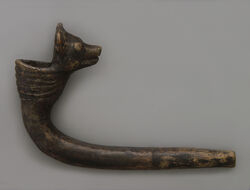Elbow pipe with animal figure
April 2022

With tobacco pipes of the American Indians, the association is quickly made with the specimens in catlinite, the red stone that was mainly used by the Sioux tribe. However, much older pipes come from the Iroquois, the Native American people who inhabited eastern North America for centuries. They live from agriculture and hunting and they have known smoking long before the Europeans settled there. Their pipes are excavated from grave finds in which, in addition to a single piece of jewelry, the deceased's beloved smoking instrument is conferred. The example shown here, added to our collection over a year ago, is representative for the Iroquois. A fairly simple smoking pipe was made from hand-rolled and modeled clay, which was baked into pottery in a field kiln. Due to smoke development during firing, the object has acquired the smothered brown-black color. The horizontal stem and vertical bowl are connected by an elbow shape, characteristic of this Indian tribe. At the front of the funnel-shaped bowl with concentric rings, an animal figure is sculpted, sometimes also a human. Here it appears to be a dog or perhaps a coyote, the American wolf, who is looking at the smoker with his head above the rim of the pipe bowl. The pipe has something primitive in the non-smooth stem and irregular rings. At the same time, the animal head is well done with simple shapes, giving the pipe a real character. It is a type that was especially popular in the sixteenth and seventeenth centuries and was subsequently replaced by goods imported from Europe. For the Indians, these imported tobacco pipes had a higher status.
Amsterdam Pipe Museum APM 24.444a
Permalink